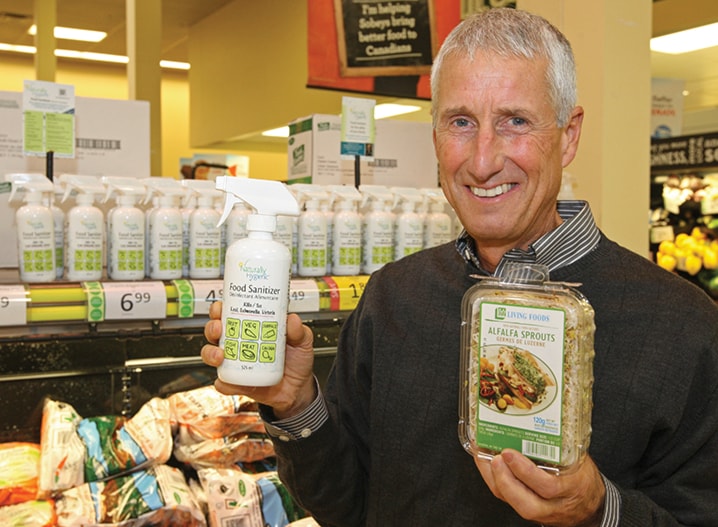Russian scientists working during the paranoid era of the Cold War can take a healthy measure of credit for leading-edge technology aimed at keeping deadly bacteria out of the food supply.
That technology is now hard at work in an Innisfail food plant and available to consumers throughout Central Alberta and beyond.
Robert Sinnamon and his brothers, Glen and Don, have been growing vegetable sprouts on their property west of Innisfail for a number of years, marketing in major grocery stores and online under the trade names Living Foods, Sproutz Alive and Sun Sprout.
Hit hard by news reports citing sprouts as a source of E. coli, salmonella and other potentially lethal bacteria, the Sinnamons started looking for a better way to ensure that their product would be absolutely safe.
The harmful bacteria are found four layers deep in the seed, so the challenge was to find a product that could penetrate those layers without harming the seed or damaging the nutritional benefits of the sprouts, says Robert.
He and his brothers found the solution in their own neighbourhood, created by a former dairy farmer who had immigrated from Switzerland.
“I came to Canada to milk cows,” says entrepreneur Ivo Wachter, founder of Profound Technology Inc., located on the east side of Innisfail.
Wachter’s family had operated a meat processing plant near Zurich for five generations and spanning more than 100 years.
Wachter, his mother and his brothers took over operations from his father in the early 1990s, when food safety had become a major concern throughout Europe.
At the same time, a group of scientists who had been working behind the Iron Curtain found themselves quite suddenly on their own. Shortly after the collapse of the Soviet Union, the Wachters encountered a Russian engineer who had helped develop a water ionization process that could produce an antibacterial agent without eating up the equipment being used to make it.
Water ionization or water electrolysis was already known to produce a highly effective anti-bacterial agent that breaks down to pure water with a minute residue of salt.
However, because ionized water is highly corrosive, there had been no effective way to produce it without eating up the machinery being used in the process.
The engineer had been on a team of 1,500 Russian scientists who solved the puzzle, says Wachter.
They had been put to the task by Soviet leaders who feared a biological attack from the United States and its allies, he says.
Using a crude machine the Russian built for them, the Wachters tested the product in their meat plant and sent swabs to a national laboratory for testing.
The results were well beyond Europe’s high standards, says Wachter. One sample was deemed sterile, he says.
He and his brothers fine-tuned the Russian process, using the end product to cleanse the meat they were processing and to sanitize hard surfaces in the plant.
At one point, an international bottling company approached them about selling the product. Representatives from the company came to the plant for a look. Instead of striking a deal, they tried to copy it, says Wachter. The result was $30 million in damage to the pipes in the plant they had built in an effort to immitate what the Wachters had done, he says.
Wachter moved to Canada in the mid-1990s after he and his brothers sold the meat plant, including their water ionization process, to a larger company.
After a few years in the dairy business, he decided to sell out and set up a new water electrolysis shop in Innisfail, believing food safety standards in Canada to be about 15 years behind Europe and hoping to capitalize on the process he had helped create.
The big break came two years ago, when the Canadian Food Inspection Agency accepted Biostel as a microbial control agent for use as process water for fruits, vegetables, red meats and poultry as well as a sanitizer for hard surfaces.
Health Canada confirmed on Friday that the reference listing remains in place, most recently updated on July 26.
Officials from the CFIA declined further comment on the process.
For Robert Sinnamon, the CFIA approval, along with testing by a renowned microbiologist from Guelph University, was the break he needed to ensure that his customers were receiving a safe and healthy product.
He and his brothers changed their process to incorporate Biostel.
The seeds are soaked in full-strength solution for 24 hours, and then placed on sterilized stainless steel trays for sprouting. Over the next four days, they are misted 195 times with reverse-osmosis water that has been injected with Biostel. They are misted once more just before packaging.
Sinnamon says there have been noticeable changes since making the switch. The seeds keep longer and the trays no longer develop a biofilm during the sprouting process.
“Every living food has the potential to carry harmful bacteria and we all know that we should be eating more leafy greens,” says Sinnamon.
“This product not only kills pathogens like E.coli, salmonella and Listeria, but also oxidizes herbicides and pesticides. It is easy and convenient to use because there is no need to rinse it off,”
Wachter markets Biostel as a multi-faceted product for use in food processes and treating water wells. He has no plans to sell the process itself.
Sinnamon Brothers Holdings Ltd. also markets Biostel under its own company, BioHygienic Solutions Inc.
bkossowan@www.reddeeradvocate.com
